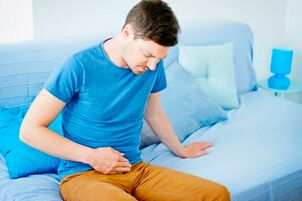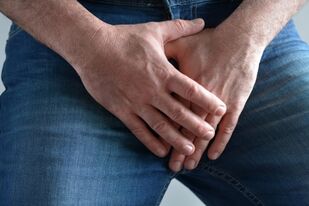
Like any other disease, prostatitis manifests itself in certain symptoms. It is important for a person to know the first signs accurately, because this is a signal to see a doctor for further examination. In this article, we will discuss how different forms of inflammation of the prostate and first aid measures manifest themselves.
A brief introduction to the prostate and prostatitis
The prostate of an adult male is a glandular organ composed of two lobules, a small sac, and an adjacent prostatic urethra. The prostate performs 3 functions at once:
- Adjust semen density by producing prostate juice and diluting ejaculation.
- Blocking the urethra during orgasm.
- Participate in the production of certain hormones or control their levels in the body.
If a person's reproductive system fails, the initial signs will be related to these functions of the prostate.
As pathogenic microorganisms invade the prostate or are injured, hypothermia and stagnation process, inflammation begins. In this case, the blood microcirculation is disturbed, and the outflow of lymphatic, venous blood and prostate secretions worsens. This leads to the development of edema and enlargement of the glands. As a result, the tissue is compressed, the person feels heaviness in the perineum, or has slight pain in the lower abdomen (this is a sign of impending prostatitis).
The clinical situation will largely depend on the form of the inflammatory process and its cause.
Symptoms of acute bacterial prostatitis
It's hard to miss the first symptoms of acute prostatitis-they appear suddenly and develop rapidly. It usually takes 2-4 days between the onset of the inflammatory process and the first symptoms. In this case, the clinical situation will depend on the stage of the disease.
In this case, the clinical situation will depend on the stage of the disease.
Acute catarrhal inflammation
Acute follicular inflammation
At this stage, the initial signs of prostatitis will be more obvious. Many men no longer take the risk of self-medication, but go to see a doctor. Complaints will be very different:
- There is dull pain in the perineum, which may radiate to the tailbone or anus.
- Urination is painful and the person is experiencing difficulty, which means that acute retention of urine may occur.
- Pain during bowel movements, so the person cannot go to the toilet.
These are the initial symptoms of follicular acute prostatitis, and further may be fever to 38 degrees, general depression, weakness, and lethargy. Men become irritable, lower libido, and erectile dysfunction may appear.
These symptoms persist, and without proper treatment, they will enter the next stage.
Acute parenchymal inflammation
The inflammatory process has spread to parenchymal tissues, so it is developing rapidly. The first thing a patient will notice is a high body temperature (from 39°C), chills, and dry mouth. Severe pain is felt in the perineum and lower back, abdomen and genitals.
Urination will also change. A person will first notice the intermittent flow of water, and then due to severe pain, he will not be able to empty the bladder at all. If you do not call an ambulance, then there will be signs of indigestion-bloating, constipation, pain in different parts of the abdomen. The foul-smelling mucus is discharged from the anus.
You can understand that substantial acute prostatitis has begun to be characterized by its characteristics: if you lie on your back and lift your legs, the pain will be less. This clearly shows the urgent need for medical care.
The first signs of chronic prostatitis

Chronic prostatitis is a long-term inflammation of the prostate, so the initial symptoms usually begin in an acute form. However, a person sometimes expects to get worse, and here you need to know what symptoms they may have. Men most often complain about the following health problems:
- Burns around the glans, especially during ejaculation or urination;
- Body temperature rises slightly.
With chronic prostatitis, erectile problems and the ability to participate in the conception of children inevitably occur. This is attributed to the deterioration of prostate function, which leads to changes in blood supply to the penis, and deterioration of sperm quality.
At the first signs of worsening prostatitis, you need treatment. It is not recommended to use the medicine prescribed by the doctor earlier without preliminary examination.
Clinical pictures of the disease
Regardless of the form of the inflammatory process and its causes, a person will have obvious triads, but the intensity of their manifestations is different. Prostatitis is always accompanied by dysuria, pain and erectile dysfunction.
Urine from prostatitis is excreted as drops or its flow is intermittent. Sometimes a jet stream is sprayed, and then a person cannot meet a small part of the demand while standing. The urge to urinate occurs more at night, especially in the morning. When there are stones in the prostate, the urine may turn pink due to blood mixing.

Prostatitis causes epithelial cells and other cells to accumulate in the urethra, and bacteria can also multiply. This leads to increased burning pain during urination or ejaculation.
Pain cannot be avoided. Depending on the severity of the pathological process, they can be:
- Complain;
- stupid;
- Shooting (pulsation).
Their most common location is the perineal area, located below the testicles. Irradiation to the tailbone, bone, pubis, and penis is not excluded. In addition, anal pain may appear on the anus, especially during pushing, because men often experience constipation.
As for body temperature, it rarely rises to 38 degrees. Substantial and suppurative prostatitis are the exceptions, which can reach 40 degrees and are accompanied by chills, severe depression and sometimes confusion. In this case, the body temperature of suffering from prostatitis can threaten the life of the patient.
First aid for prostatitis
If we do not talk about purulent processes, prostatitis can also be treated in an outpatient clinic. But even in this case, it is indispensable to go to the doctor for referral to check and choose treatment strategies. However, when a man cannot call an ambulance, the first symptoms of prostatitis may appear, so you need to understand some first aid principles.

- When the temperature rises above 38 degrees, you can take anti-fever medicine.
- To relieve pain, it is best to lie on your back and raise your legs (leaning against a wall or furniture).
- For particularly severe pain, you can drink antispasmodics or insert suppositories.
You need to see a doctor as soon as possible, and at the reception you will need to tell what medicine you have taken and what dose you have taken.
Traditional methods can only be used after confirming the diagnosis and obtaining the permission of the attending doctor.
How does prostatitis manifest itself in analysis
Prostatitis refers to a disease without inherent symptoms. For example, a burning sensation when urinating may be urethritis, and lower abdomen pain may be appendicitis or cystitis. Therefore, the final diagnosis is not based on the patient's main complaint, but on the results of laboratory tests of blood, urine, semen and prostate fluid. Data from rectal examination, TRUS and many other instrument methods are also considered.
The following diagnostic features are features of prostatitis:
- Bacteria or fungi are present in urine and prostate fluid.
- There are white blood cells in urine and blood tests.
- The number of white blood cell granules decreases with the increase of the number of white blood cells in the prostate secretion as a background;
- Blood in urine or semen;
- The erythrocyte sedimentation rate decreased during the blood test.
- Pain on palpation of the prostate, changes in size and consistency.
- Echoicity, granularity and contour changes based on TRUS results.
These signs, combined with complaints about happiness, enable us to make an accurate diagnosis, which means that the treatment plan will be formulated correctly. The patient's quality of life, the speed of recovery, and in some cases, the patient's life also depends on this.
Conclusion
After understanding the initial symptoms of male prostatitis, you can learn about health changes in time and take action in advance. If the pain in the perineum begins, urine will become scarce and the urge to urinate will become more frequent-this is the cause of suspected prostatitis and a sign to see a doctor. In this case, it is best not to take the medicine yourself.

























